Instrumentation
Ozone • PM2.5 • PM2.5 Speciation • Carbon Monoxide • Nitrogen Dioxide • Sulfur Dioxide • Meteorological
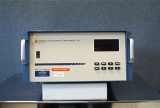 Thermo Environmental Instruments (TEI) Model 49C Ozone analyzer: The analyzer samples local ambient air quality at the averaging intervals of 1, 5, 60 and 480 minutes. The data are automatically logged with the data acquisition systems. The unit is setup and operated to monitor ambient ozone concentrations up to 500 parts per billion. The one hour ozone average is reported to the EPA AIRNow website and converted and reported as an Air Quality Index (AQI). Principle Utilized: The analyzer uses the principle of ultraviolet absorption; whereby ozone molecules absorb ultraviolet energy at a known wave length of 254nm. The UV light available for detection is proportional to the amount of ozone in the sample chamber.
Thermo Environmental Instruments (TEI) Model 49C Ozone analyzer: The analyzer samples local ambient air quality at the averaging intervals of 1, 5, 60 and 480 minutes. The data are automatically logged with the data acquisition systems. The unit is setup and operated to monitor ambient ozone concentrations up to 500 parts per billion. The one hour ozone average is reported to the EPA AIRNow website and converted and reported as an Air Quality Index (AQI). Principle Utilized: The analyzer uses the principle of ultraviolet absorption; whereby ozone molecules absorb ultraviolet energy at a known wave length of 254nm. The UV light available for detection is proportional to the amount of ozone in the sample chamber.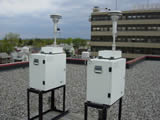 R&P Partisol-Plus Model 2025 Sequential Air Sampler: This PM2.5 Federal Reference Method (FRM) samples local ambient air quality every day, every third day or every sixth day (depending on the particular site schedule) for a period of 24 hours. Principle Utilized: Air is sampled at a rate of 1 m3 per hour and the particulate matter is collected on a Teflon filter that is weighed both before and after sampling. Currently, sharp-cut cyclones (VSCC) are used as the PM size separator.
R&P Partisol-Plus Model 2025 Sequential Air Sampler: This PM2.5 Federal Reference Method (FRM) samples local ambient air quality every day, every third day or every sixth day (depending on the particular site schedule) for a period of 24 hours. Principle Utilized: Air is sampled at a rate of 1 m3 per hour and the particulate matter is collected on a Teflon filter that is weighed both before and after sampling. Currently, sharp-cut cyclones (VSCC) are used as the PM size separator.
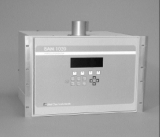 MetOne Instruments BAM 1020 Beta Attenuation Monitor: The MetOne BAM samples local ambient air quality 24 hours a day, 365 days a year. The MetOne BAM continuously measures PM2.5 mass. The one hour PM2.5 average is reported to the EPA AIRNow website and converted and reported as an Air Quality Index (AQI). Principle Utilized: At the beginning of the sampling period, beta ray transmission is measured across a clean section of filter tape for five minutes. This section of the tape is then mechanically advanced to the sampling inlet. Fine particle matter is then drawn into the sample inlet and deposited on the filter paper for 50 minutes. At the completion of the sampling period, the filter tape is returned to its original location and the beta ray transmission is re-measured for 5 minutes. The difference between the two measurements is used to determine the particle concentration.
MetOne Instruments BAM 1020 Beta Attenuation Monitor: The MetOne BAM samples local ambient air quality 24 hours a day, 365 days a year. The MetOne BAM continuously measures PM2.5 mass. The one hour PM2.5 average is reported to the EPA AIRNow website and converted and reported as an Air Quality Index (AQI). Principle Utilized: At the beginning of the sampling period, beta ray transmission is measured across a clean section of filter tape for five minutes. This section of the tape is then mechanically advanced to the sampling inlet. Fine particle matter is then drawn into the sample inlet and deposited on the filter paper for 50 minutes. At the completion of the sampling period, the filter tape is returned to its original location and the beta ray transmission is re-measured for 5 minutes. The difference between the two measurements is used to determine the particle concentration.![]()
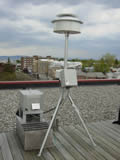 MetOne SASS Sampler: The MetOne SASS unit measures PM2.5 mass and the chemical composition of PM2.5. This is known as PM2.5 chemical speciation. The MetOne SASS is located in New Haven CT at the Criscuolo Park monitoring site and is part of the EPA Speciation Trends Network (STN). The MetOne SASS samples on a 1-in-3 day sampling schedule. Data is validated on a monthly basis when reports are received from the contract laboratory (Research Triangle Institute).
MetOne SASS Sampler: The MetOne SASS unit measures PM2.5 mass and the chemical composition of PM2.5. This is known as PM2.5 chemical speciation. The MetOne SASS is located in New Haven CT at the Criscuolo Park monitoring site and is part of the EPA Speciation Trends Network (STN). The MetOne SASS samples on a 1-in-3 day sampling schedule. Data is validated on a monthly basis when reports are received from the contract laboratory (Research Triangle Institute). IMPROVE Sampler: The IMPROVE (Interagency Monitoring of Protected Visual Environments) sampler, which measures PM2.5 mass, PM10 mass and PM2.5 chemical speciation, operates on a 1-in-3 day sampling schedule in Cornwall, CT at the Mohawk Mountain monitoring site. Data is validated at the Crocker Nuclear Laboratory at University of California-Davis and is then reported to the operating site usually within a 6-month period.
IMPROVE Sampler: The IMPROVE (Interagency Monitoring of Protected Visual Environments) sampler, which measures PM2.5 mass, PM10 mass and PM2.5 chemical speciation, operates on a 1-in-3 day sampling schedule in Cornwall, CT at the Mohawk Mountain monitoring site. Data is validated at the Crocker Nuclear Laboratory at University of California-Davis and is then reported to the operating site usually within a 6-month period.The data produced by both the STN and IMPROVE networks are widely used in determining PM sources and the effectiveness of control strategies.
 Thermo Environmental Instruments (TEI) Model 48C Gas Filter Correlation Analyzer: The carbon monoxide instrument samples local ambient air quality 24 hours a day, 365 days a year. Carbon monoxide averaging intervals of 1, 5, 60 and 480 minutes are automatically logged with the data acquisition systems. Principle Utilized: The instrumental operation utilizes the principle of "Gas Filter Correlation" that is based on the fact that carbon monoxide molecules absorb infrared radiation at a know spectral wavelength of 4.6 mm. The infrared absorption characteristic is a non-linear technique. The TEI Model 48C electronics package transforms the data output to a linear format. The signal is then processed to digital and analog outputs and captured by the data acquisition system.
Thermo Environmental Instruments (TEI) Model 48C Gas Filter Correlation Analyzer: The carbon monoxide instrument samples local ambient air quality 24 hours a day, 365 days a year. Carbon monoxide averaging intervals of 1, 5, 60 and 480 minutes are automatically logged with the data acquisition systems. Principle Utilized: The instrumental operation utilizes the principle of "Gas Filter Correlation" that is based on the fact that carbon monoxide molecules absorb infrared radiation at a know spectral wavelength of 4.6 mm. The infrared absorption characteristic is a non-linear technique. The TEI Model 48C electronics package transforms the data output to a linear format. The signal is then processed to digital and analog outputs and captured by the data acquisition system.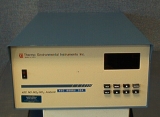 Thermo Environmental Instruments (TEI) Model 42C Chemiluminescence Oxides of Nitrogen Analyzer: The instrument samples local ambient air quality 24 hours a day, 365 days a year. Averaging intervals of 1, 5 and 60 minutes are automatically logged with the data acquisition systems. Principle Utilized: The instrumental operation utilizes the principle of "Chemiluminescence" that is based on the rapid gas phase reaction of nitric oxide molecules and ozone molecules. The TEI Model 42C electronics package transforms the data output to a linear format. The signal is then processed to digital and analog outputs and captured by the data acquisition system.
Thermo Environmental Instruments (TEI) Model 42C Chemiluminescence Oxides of Nitrogen Analyzer: The instrument samples local ambient air quality 24 hours a day, 365 days a year. Averaging intervals of 1, 5 and 60 minutes are automatically logged with the data acquisition systems. Principle Utilized: The instrumental operation utilizes the principle of "Chemiluminescence" that is based on the rapid gas phase reaction of nitric oxide molecules and ozone molecules. The TEI Model 42C electronics package transforms the data output to a linear format. The signal is then processed to digital and analog outputs and captured by the data acquisition system.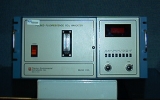 Thermo Environmental Instruments (TEI) Model 43A Pulsed Fluorescence Analyzer: The instrument samples local ambient air quality 24 hours a day, 365 days a year. Averaging intervals of 1, 5 and 60 minutes are automatically logged with the data acquisition systems. Principle Utilized: The instrumental operation utilizes the principle of "Pulsed Fluorescence" that is based on the fact that sulfur dioxide molecules absorb fluorescent energy, producing electronically excited SO2 molecule with a known spectral decay rate to the ground state. The fluorescence emitted by the reaction is detected by a photo multiplier tube and the signal is converter proportionally to a electronic output signal. The signal is then processed to digital and analog outputs and captured by the data acquisition system.
Thermo Environmental Instruments (TEI) Model 43A Pulsed Fluorescence Analyzer: The instrument samples local ambient air quality 24 hours a day, 365 days a year. Averaging intervals of 1, 5 and 60 minutes are automatically logged with the data acquisition systems. Principle Utilized: The instrumental operation utilizes the principle of "Pulsed Fluorescence" that is based on the fact that sulfur dioxide molecules absorb fluorescent energy, producing electronically excited SO2 molecule with a known spectral decay rate to the ground state. The fluorescence emitted by the reaction is detected by a photo multiplier tube and the signal is converter proportionally to a electronic output signal. The signal is then processed to digital and analog outputs and captured by the data acquisition system.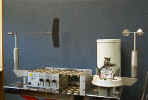 Climatronics Corporation: The CT DEP monitors wind speed, wind direction, inside temperature, outside temperature, dew point, barometric pressure, solar radiation, and precipitation. The signal is then processed to analog outputs and captured by the data acquisition system.
Climatronics Corporation: The CT DEP monitors wind speed, wind direction, inside temperature, outside temperature, dew point, barometric pressure, solar radiation, and precipitation. The signal is then processed to analog outputs and captured by the data acquisition system.
Content last updated on March 2, 2011

